
Progress 0%
Ridding the world of unnecessary packaging: Nohbo with Benjamin Stern
World's first land-based coral farm: Coral Vita with Sam Teicher
Climate-resilient agriculture: The Cacao Project with Louise Mabulo
Cleaning up floating ocean plastics: The Ocean CleanUp with Boyan Slat
Eliminating the idea of waste: TerraCycle with Tom Szaky
A circular model for second-hand clothing: FabricAID with Omar Itani
Planting trees, one goal at a time: Trees4Goals with Lesein Mutunkei
Exchanging waste for plants: Eco Star with Fatemah Alzelzela
Innovative technology to reduce rice waste: Rice Inc with Kisum Chan
Do you have questions?
Ask The Earth Prize Mentors!
Key Concepts
Environmentalism
Sustainable
Development
Carrying
Capacity
Ecological
Footprint
Carbon
Footprint
Earth
Overshoot Day
Environmentalism
Sustainable
Development
Carrying
Capacity
Ecological
Footprint
Carbon
Footprint
Earth
Overshoot Day
Environmentalism
Sustainable
Development
Carrying
Capacity
Ecological
Footprint
Carbon
Footprint
Earth
Overshoot Day
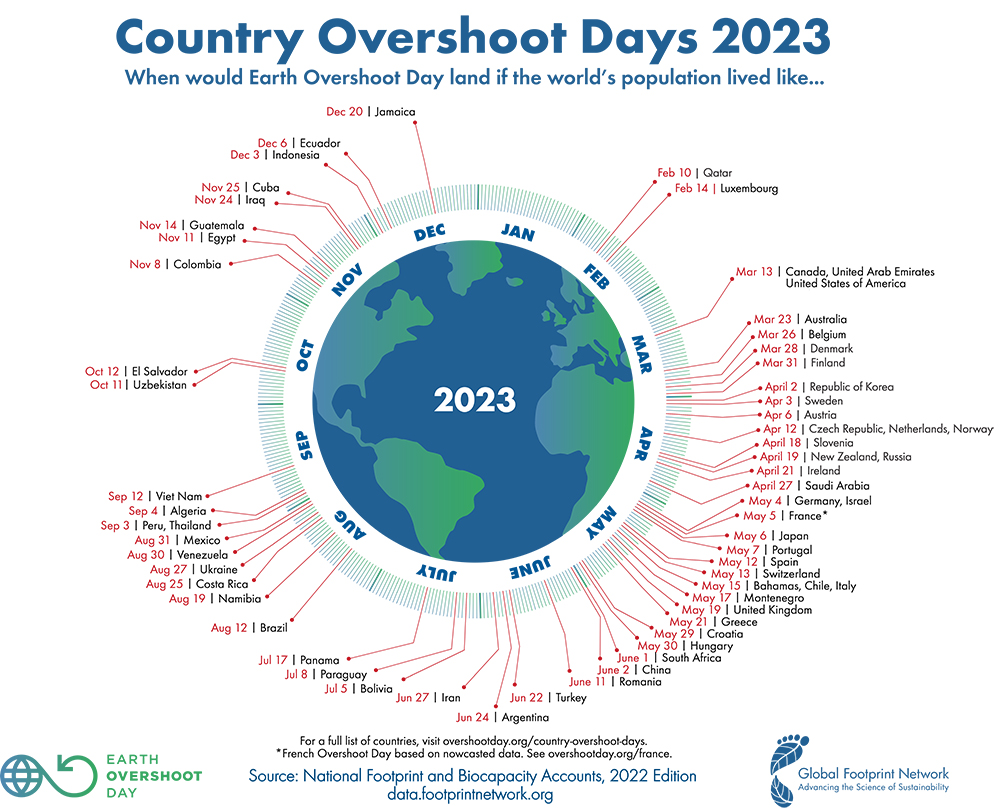
Earth
Overshoot Day
This marks the date when humanity’s demand for ecological resources and services in a given year exceeds what Earth can regenerate in that year. (5) From that date onwards, until the end of the year, essentially, humans are resorting to the “Earth’s piggy bank” of resources in order to continue with their lifestyle. Earth Overshoot Day 2023 fell on 2 August, 2023.
You can check how the date of Earth Overshoot Day 2022 was calculated here.
Environmentalism
The term is used to describe actions and policies which show a concern about protecting and preserving the natural environment from damage caused by human activities. (1) It involves taking action to build a society capable of adapting to a rapidly changing Earth and understanding sustainable ways to live in it.
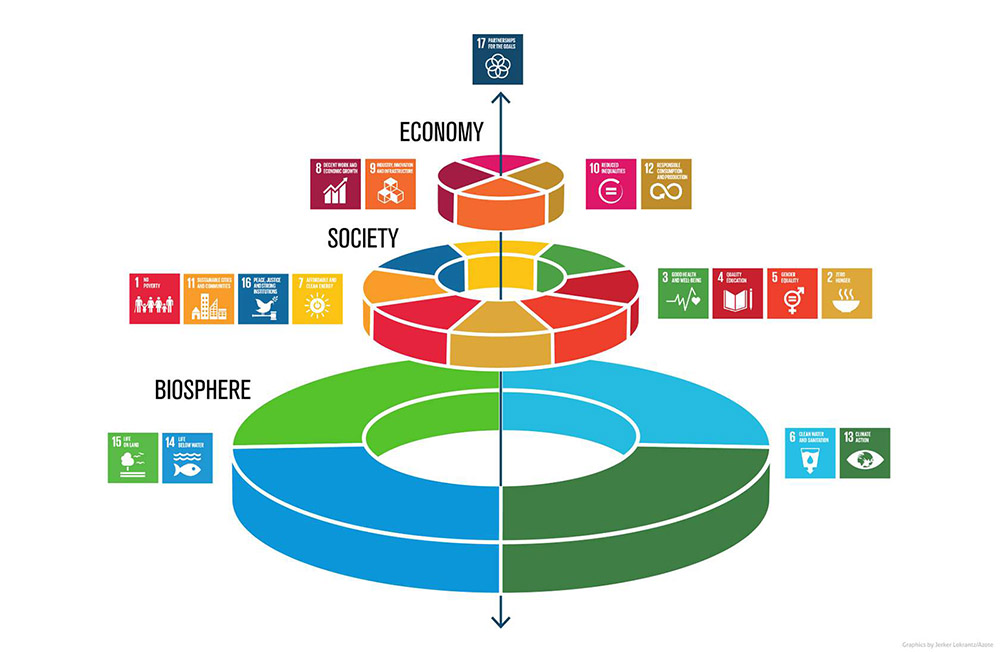
Sustainable
Development
This is development that meets the needs of the present without compromising the ability of future generations to meet their own needs. (International Institute for Sustainable Development) The concept of sustainability is frequently used as a synonym for sustainable development and means preserving the Earth’s capacity to sustain and to support mankind.
Photo source: Stockholm Resilience Centre, Stockholm University
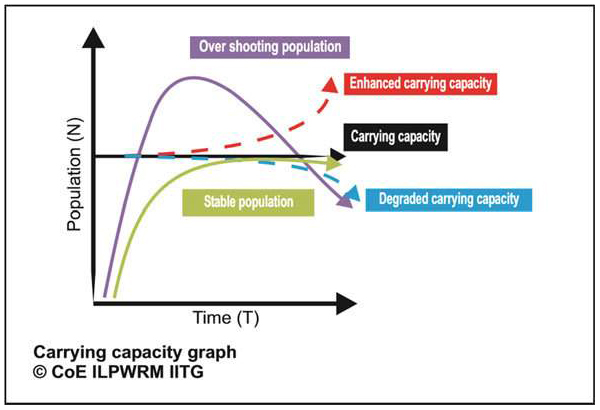
Carrying
Capacity
This means the number of individuals an environment can support without significant negative impacts to the given organism and its environment. (2)
Ecological
Footprint
This indicates how many hectares of forest, pasture, farmland, and marine land are needed to renew the resources consumed and to absorb the waste produced. It enables us to compare the effects of our current consumption with the Earth's available resources. The consumer behavior of the world's population is currently causing a total deficit, which means that mankind would need 1.7 Earths to compensate for this behavior. (3)
To calculate your personal ecological footprint, you can use the following calculator: Global Footprint Network.
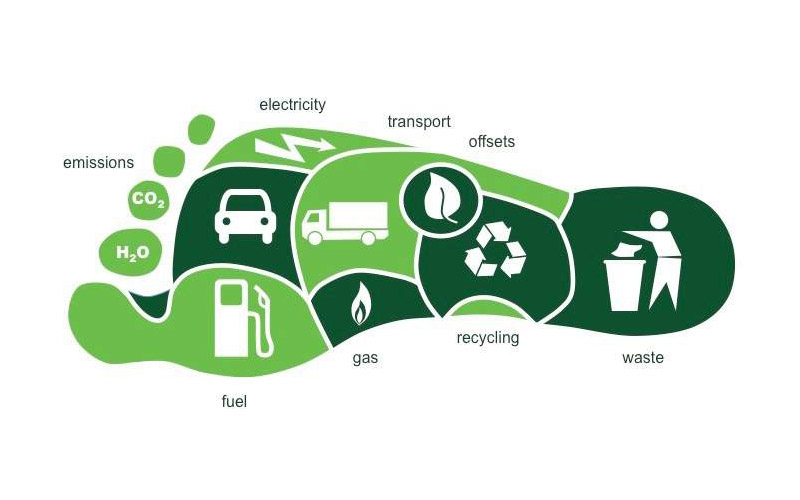
Carbon
Footprint
It refers to the amount of carbon dioxide released into the atmosphere as a result of the activities of a particular individual, organization, or community. (4) It is expressed as a weight of CO2 emissions produced in tonnes. Our Carbon footprint is an important indicator of our behavior’s impact on global warming. To measure your personal carbon footprint, you can use one of the multiple calculators available online: WWF, TerraPass or the UN.
Photo source: Bioninja

Earth
Overshoot Day
This marks the date when humanity’s demand for ecological resources and services in a given year exceeds what Earth can regenerate in that year. (5) From that date onwards, until the end of the year, essentially, humans are resorting to the “Earth’s piggy bank” of resources in order to continue with their lifestyle. Earth Overshoot Day 2023 fell on 2 August, 2023.
You can check how the date of Earth Overshoot Day 2022 was calculated here.
Environmentalism
The term is used to describe actions and policies which show a concern about protecting and preserving the natural environment from damage caused by human activities. (1) It involves taking action to build a society capable of adapting to a rapidly changing Earth and understanding sustainable ways to live in it.

Sustainable
Development
This is development that meets the needs of the present without compromising the ability of future generations to meet their own needs. (International Institute for Sustainable Development) The concept of sustainability is frequently used as a synonym for sustainable development and means preserving the Earth’s capacity to sustain and to support mankind.
Photo source: Stockholm Resilience Centre, Stockholm University

Carrying
Capacity
This means the number of individuals an environment can support without significant negative impacts to the given organism and its environment. (2)
Ecological
Footprint
This indicates how many hectares of forest, pasture, farmland, and marine land are needed to renew the resources consumed and to absorb the waste produced. It enables us to compare the effects of our current consumption with the Earth's available resources. The consumer behavior of the world's population is currently causing a total deficit, which means that mankind would need 1.7 Earths to compensate for this behavior. (3)
To calculate your personal ecological footprint, you can use the following calculator: Global Footprint Network.

Carbon
Footprint
It refers to the amount of carbon dioxide released into the atmosphere as a result of the activities of a particular individual, organization, or community. (4) It is expressed as a weight of CO2 emissions produced in tonnes. Our Carbon footprint is an important indicator of our behavior’s impact on global warming. To measure your personal carbon footprint, you can use one of the multiple calculators available online: WWF, TerraPass or the UN.
Photo source: Bioninja

Earth
Overshoot Day
This marks the date when humanity’s demand for ecological resources and services in a given year exceeds what Earth can regenerate in that year. (5) From that date onwards, until the end of the year, essentially, humans are resorting to the “Earth’s piggy bank” of resources in order to continue with their lifestyle. Earth Overshoot Day 2023 fell on 2 August, 2023.
You can check how the date of Earth Overshoot Day 2022 was calculated here.

Currently, people’s desire to consume has grown out of proportion. The global consumption of resources outweighs the capacity of the planet to generate them, and the increase in pollution and waste is only intensifying the problem. The planet’s natural resources are enough to meet the entire population’s basic needs. However, the uneven geographical distribution and inequalities in access to resources mean that some people are consuming beyond the Earth’s limit while others cannot meet their basic needs. You can read more about the distribution of resources here.
If human activity continues at the current pace, we will need at least 2 more planets by 2050 in order to sustain our present lifestyles. (8) Wealthy nations are using natural resources at such rates that developing countries have little left for themselves. (9)
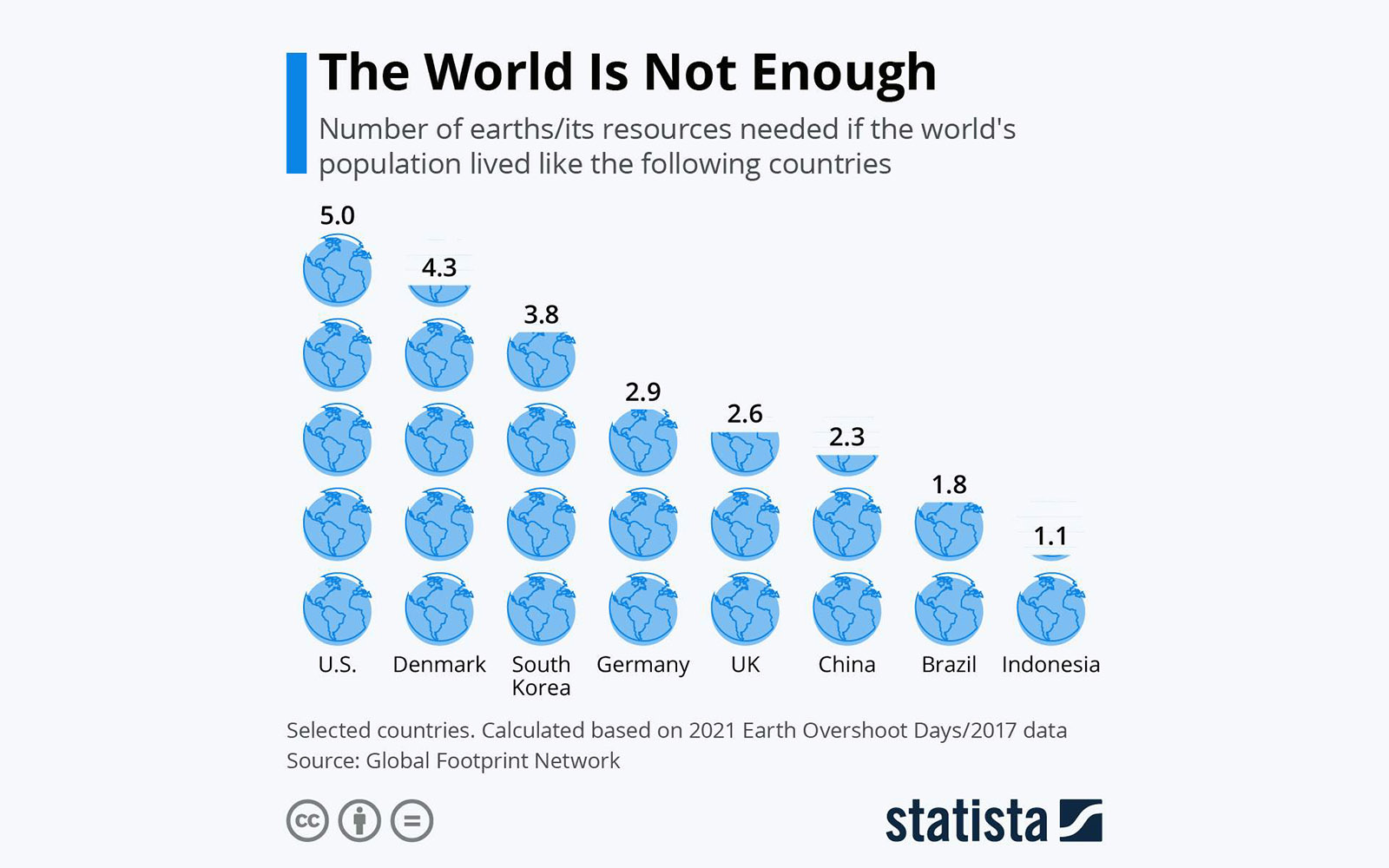
Sustainable vs. Unsustainable
Sustainability is a broad topic that includes more than just taking care of the environment; it also includes economic and social factors. Regarding environmental sustainability, there are clear differences between what is sustainable and unsustainable.
Sustainable refers to the ability to be maintained at a certain rate or level, preventing the depletion (running out) of natural resources in order to maintain the ecological balance. (6) Something that is unsustainable cannot continue at the same rate, causing damage to the environment by exploiting natural resources faster than the planet can replenish (refill) them naturally. (7)
Currently, people’s desire to consume has grown out of proportion. The global consumption of resources outweighs the capacity of the planet to generate them, and the increase in pollution and waste is only intensifying the problem. The planet’s natural resources are enough to meet the entire population’s basic needs. However, the uneven geographical distribution and inequalities in access to resources mean that some people are consuming beyond the Earth’s limit while others cannot meet their basic needs. You can read more about the distribution of resources here.
If human activity continues at the current pace, we will need at least 2 more planets by 2050 in order to sustain our present lifestyles. (8) Wealthy nations are using natural resources at such rates that developing countries have little left for themselves. (9)

Sustainable vs. Unsustainable
Sustainability is a broad topic that includes more than just taking care of the environment; it also includes economic and social factors. Regarding environmental sustainability, there are clear differences between what is sustainable and unsustainable.
Sustainable refers to the ability to be maintained at a certain rate or level, preventing the depletion (running out) of natural resources in order to maintain the ecological balance. (6) Something that is unsustainable cannot continue at the same rate, causing damage to the environment by exploiting natural resources faster than the planet can replenish (refill) them naturally. (7)
Currently, people’s desire to consume has grown out of proportion. The global consumption of resources outweighs the capacity of the planet to generate them, and the increase in pollution and waste is only intensifying the problem. The planet’s natural resources are enough to meet the entire population’s basic needs. However, the uneven geographical distribution and inequalities in access to resources mean that some people are consuming beyond the Earth’s limit while others cannot meet their basic needs. You can read more about the distribution of resources here.
If human activity continues at the current pace, we will need at least 2 more planets by 2050 in order to sustain our present lifestyles. (8) Wealthy nations are using natural resources at such rates that developing countries have little left for themselves. (9)


Fast Fashion Pollution
Brands use synthetic fibers such as polyester which take years to biodegrade or shed plastic microfibers when washed. (Ocean Clean Wash) Around half a million tonnes of plastic microfibers contribute to ocean pollution every year. Clothing material made from natural fibers can also have residues of pesticides and fertilizers used during cotton farming. They can release various toxins and chemicals into the atmosphere when they are incinerated or dumped in landfills.
Learn about how to make more sustainable fashion choices here.
Photo source: IntechOpen (2017)
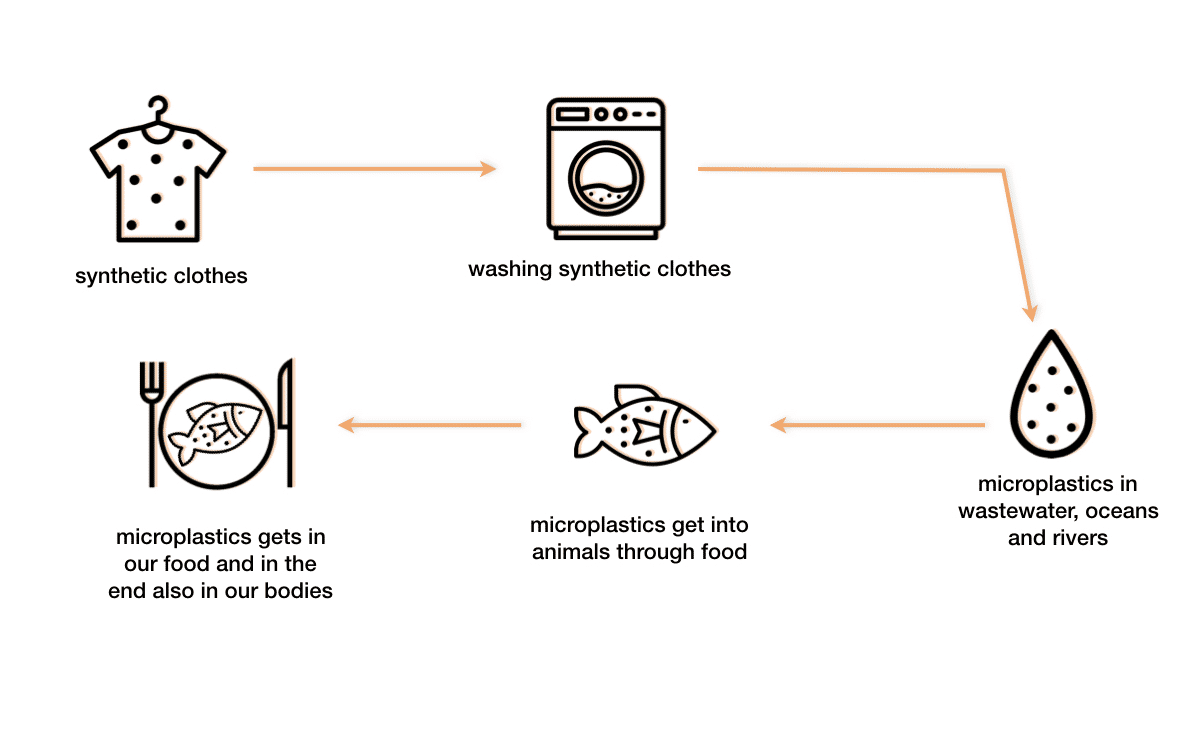
Fast fashion
Fast Fashion is a method of designing, manufacturing, and marketing clothes by producing high volumes of clothing at a rapid rate to take advantage of trends and make more profit. (Vox) Fast fashion brings cheap clothes to the consumers, which has resulted in an industry-wide shift towards an overwhelming amount of consumption.
The root of the problem lies in excessive consumerism and the throwaway culture whereby garments are worn a couple of times and then thrown away. The number of times a garment is worn has declined by 36% in 15 years. (10) The pressure to reduce cost and speed up production time in order to meet consumer demand results in increased stress on the environment.
Photo source: Stan Honda/AFP/Getty Images
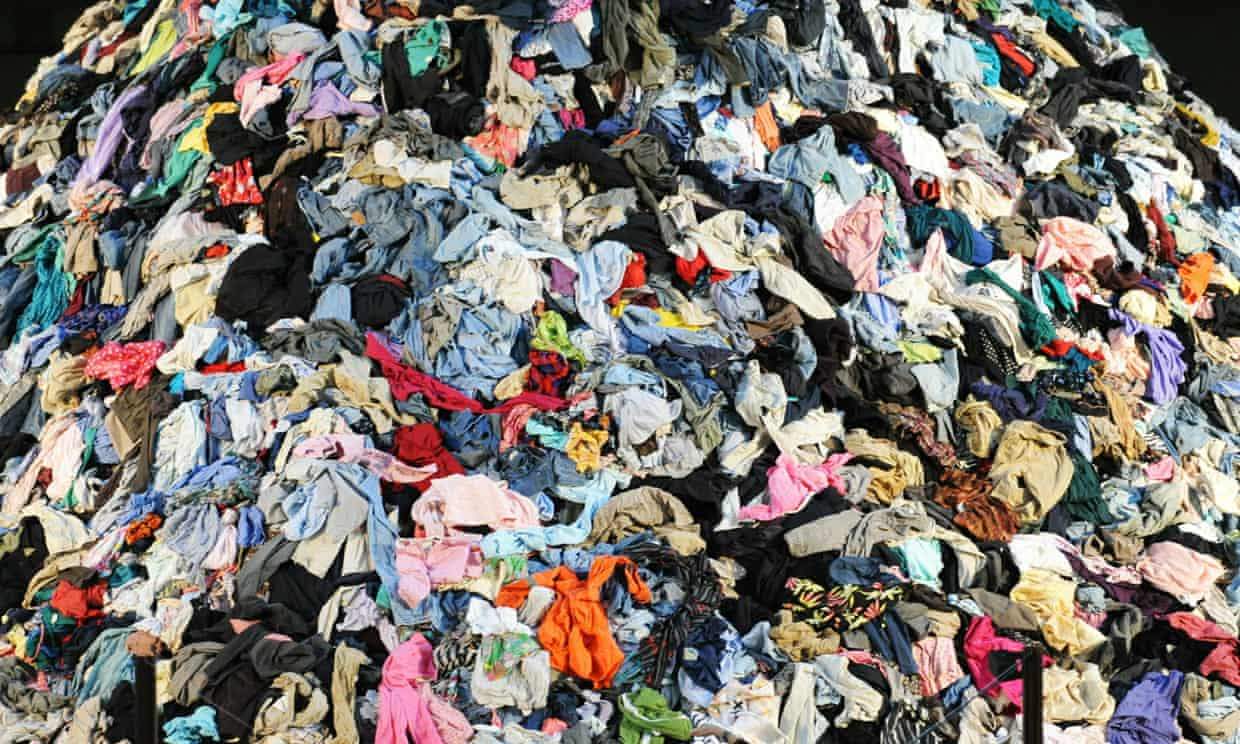
Environmental Price of Fast Fashion
More than half of fast fashion produced is disposed of in under a year and ends up in a landfill or is incinerated. (11) Large amounts of non-renewable resources are utilized to produce clothes. This places immense pressure on the resources, degrades and pollutes the environment and the wider ecosystem, and causes severe negative societal impacts at a local, regional and global level. (11)
Hazardous chemicals used in fast fashion production affect the health of both textile workers and consumers. The use of cheap, toxic textile dyes makes the fashion industry the second largest polluter of clean water globally after agriculture.
Less than 1% of the material used to produce clothing is recycled into new clothing.
Photo source: Ellen McArthur Foundation
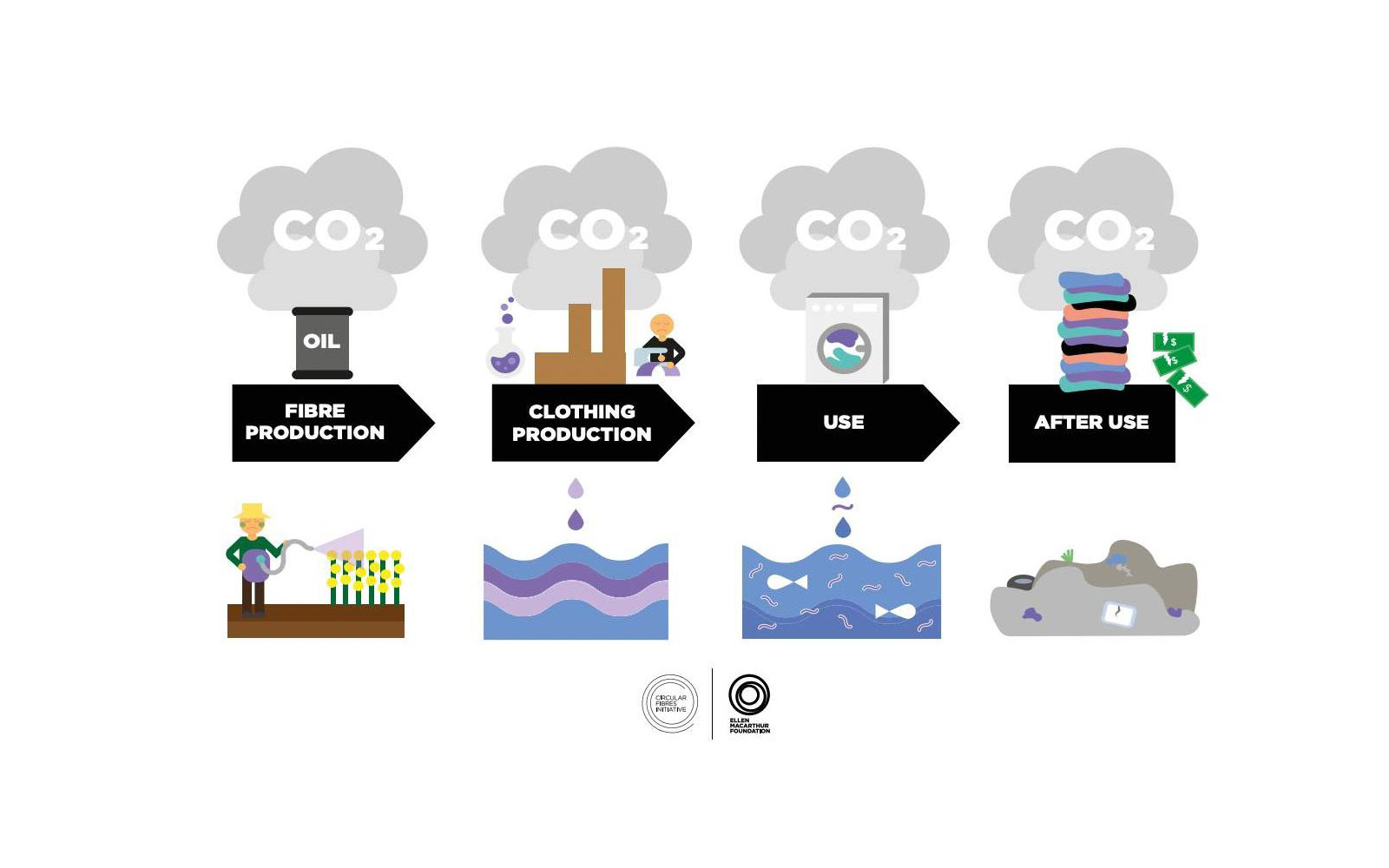
Fast Fashion Pollution
Brands use synthetic fibers such as polyester which take years to biodegrade or shed plastic microfibers when washed. (Ocean Clean Wash) Around half a million tonnes of plastic microfibers contribute to ocean pollution every year. Clothing material made from natural fibers can also have residues of pesticides and fertilizers used during cotton farming. They can release various toxins and chemicals into the atmosphere when they are incinerated or dumped in landfills.
Learn about how to make more sustainable fashion choices here.
Photo source: IntechOpen (2017)

Fast fashion
Fast Fashion is a method of designing, manufacturing, and marketing clothes by producing high volumes of clothing at a rapid rate to take advantage of trends and make more profit. (Vox) Fast fashion brings cheap clothes to the consumers, which has resulted in an industry-wide shift towards an overwhelming amount of consumption.
The root of the problem lies in excessive consumerism and the throwaway culture whereby garments are worn a couple of times and then thrown away. The number of times a garment is worn has declined by 36% in 15 years. (10) The pressure to reduce cost and speed up production time in order to meet consumer demand results in increased stress on the environment.
Photo source: Stan Honda/AFP/Getty Images

Environmental Price of Fast Fashion
More than half of fast fashion produced is disposed of in under a year and ends up in a landfill or is incinerated. (11) Large amounts of non-renewable resources are utilized to produce clothes. This places immense pressure on the resources, degrades and pollutes the environment and the wider ecosystem, and causes severe negative societal impacts at a local, regional and global level. (11)
Hazardous chemicals used in fast fashion production affect the health of both textile workers and consumers. The use of cheap, toxic textile dyes makes the fashion industry the second largest polluter of clean water globally after agriculture.
Less than 1% of the material used to produce clothing is recycled into new clothing.
Photo source: Ellen McArthur Foundation

Fast Fashion Pollution
Brands use synthetic fibers such as polyester which take years to biodegrade or shed plastic microfibers when washed. (Ocean Clean Wash) Around half a million tonnes of plastic microfibers contribute to ocean pollution every year. Clothing material made from natural fibers can also have residues of pesticides and fertilizers used during cotton farming. They can release various toxins and chemicals into the atmosphere when they are incinerated or dumped in landfills.
Learn about how to make more sustainable fashion choices here.
Photo source: IntechOpen (2017)


Environmental impact of e-waste
E-waste is not biodegradable, and therefore, extremely harmful to the environment. When it is dumped in landfills, its toxic materials leak into the groundwater, which severely affects surrounding living organisms. The harmful substances particularly threaten the health of people living in developing countries where most of the e-waste is dumped.
At a global level, the recycling rates are low. In 2019, only 17.4% of e-waste was collected and recycled globally. Highly-valued recoverable elements, estimated at $57 billion, were mostly dumped or burned instead of being collected for treatment and reuse. (Geneva Environment Network) However, even the processes used to recover valuable materials from electronic equipment release toxic substances into the natural environment. When burned or bathed in acid so precious materials can be recovered, it releases harmful chemicals into the air, which pollute the atmosphere. These processes expose workers to high levels of contaminants such as lead, which poses a great risk to the workers’ health. (12)
Minimizing e-waste will help to conserve rare materials and resources, as well as reduce the amount of energy used to produce electronic equipment. Read more about how to reduce your e-waste here.
Photo source: Global E-Waste Monitor 2020
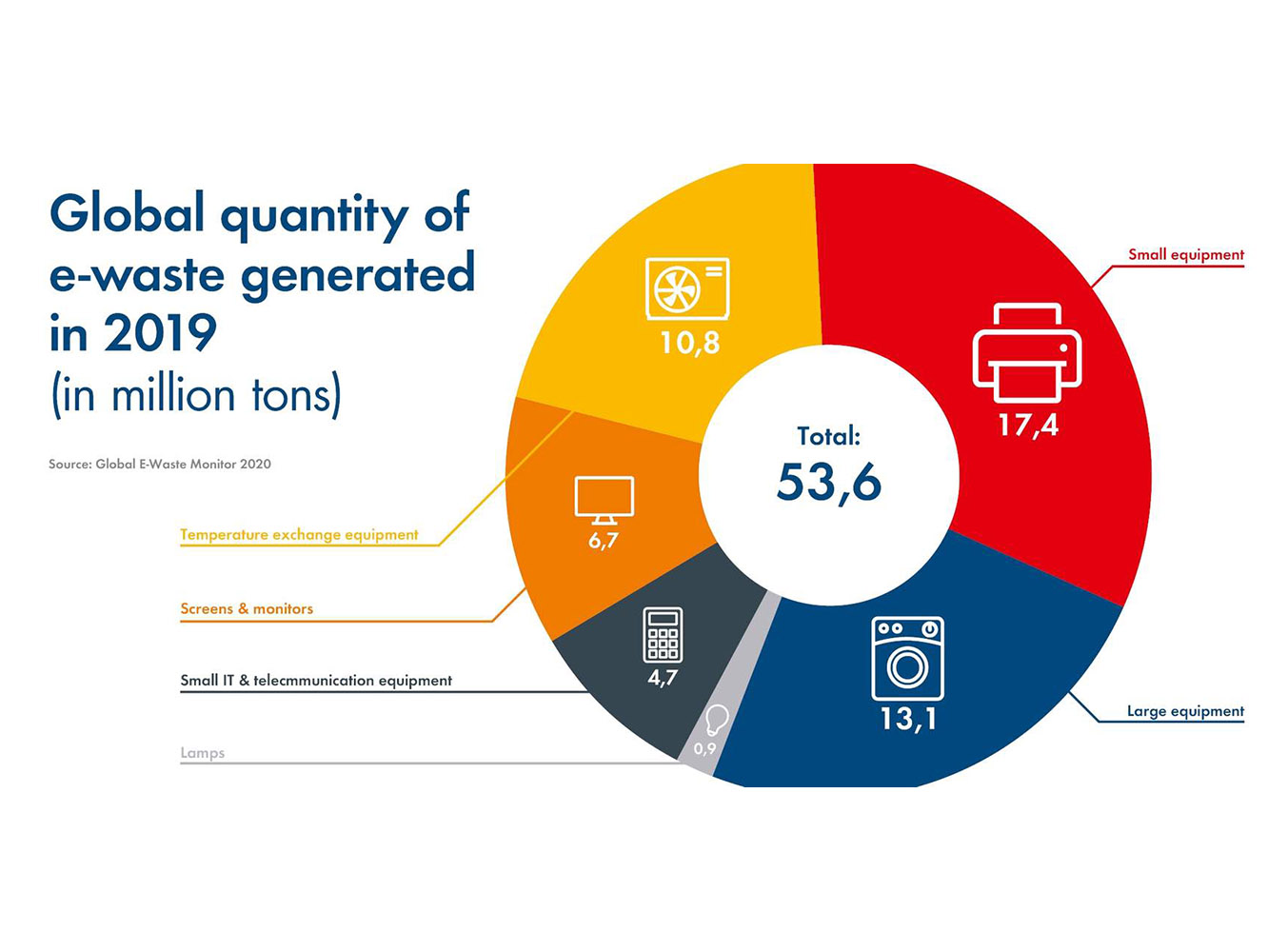
E-waste
Electronic waste, also called e-waste, can be any form of discarded electric and electronic equipment which has a battery or plug and includes toxic and harmful substances. (12) Around 50 million tonnes of e-waste is thrown away each year globally, which is expected to more than double to 110 million tonnes by 2050. (13)
E-waste is becoming the fastest growing domestic waste stream, which is driven by the consumption of electric equipment, short life cycles, and reduced repair options. (12) It is a growing global challenge that poses a serious threat to the environment and human health.
Photo source: Getty Images

Environmental impact of e-waste
E-waste is not biodegradable, and therefore, extremely harmful to the environment. When it is dumped in landfills, its toxic materials leak into the groundwater, which severely affects surrounding living organisms. The harmful substances particularly threaten the health of people living in developing countries where most of the e-waste is dumped.
At a global level, the recycling rates are low. In 2019, only 17.4% of e-waste was collected and recycled globally. Highly-valued recoverable elements, estimated at $57 billion, were mostly dumped or burned instead of being collected for treatment and reuse. (Geneva Environment Network) However, even the processes used to recover valuable materials from electronic equipment release toxic substances into the natural environment. When burned or bathed in acid so precious materials can be recovered, it releases harmful chemicals into the air, which pollute the atmosphere. These processes expose workers to high levels of contaminants such as lead, which poses a great risk to the workers’ health. (12)
Minimizing e-waste will help to conserve rare materials and resources, as well as reduce the amount of energy used to produce electronic equipment. Read more about how to reduce your e-waste here.
Photo source: Global E-Waste Monitor 2020

E-waste
Electronic waste, also called e-waste, can be any form of discarded electric and electronic equipment which has a battery or plug and includes toxic and harmful substances. (12) Around 50 million tonnes of e-waste is thrown away each year globally, which is expected to more than double to 110 million tonnes by 2050. (13)
E-waste is becoming the fastest growing domestic waste stream, which is driven by the consumption of electric equipment, short life cycles, and reduced repair options. (12) It is a growing global challenge that poses a serious threat to the environment and human health.
Photo source: Getty Images

Environmental impact of e-waste
E-waste is not biodegradable, and therefore, extremely harmful to the environment. When it is dumped in landfills, its toxic materials leak into the groundwater, which severely affects surrounding living organisms. The harmful substances particularly threaten the health of people living in developing countries where most of the e-waste is dumped.
At a global level, the recycling rates are low. In 2019, only 17.4% of e-waste was collected and recycled globally. Highly-valued recoverable elements, estimated at $57 billion, were mostly dumped or burned instead of being collected for treatment and reuse. (Geneva Environment Network) However, even the processes used to recover valuable materials from electronic equipment release toxic substances into the natural environment. When burned or bathed in acid so precious materials can be recovered, it releases harmful chemicals into the air, which pollute the atmosphere. These processes expose workers to high levels of contaminants such as lead, which poses a great risk to the workers’ health. (12)
Minimizing e-waste will help to conserve rare materials and resources, as well as reduce the amount of energy used to produce electronic equipment. Read more about how to reduce your e-waste here.
Photo source: Global E-Waste Monitor 2020


Landfills vs. composting
Most food waste ends up in landfills. However, to decompose it needs free-flowing oxygen. In the landfills, food waste is frequently tied in plastic bags and surrounded by more waste, and as a result, it undergoes a process called anaerobic decomposition. This type of oxygen-less decomposition causes the waste to release important amounts of methane (CH4) - a more powerful greenhouse gas than carbon dioxide (CO2). When food is composted in a well-maintained bin that lets in oxygen, it reduces the release of methane and contributes to healthier soils. (17) However, only a low percentage of all food is composted.
Part of the problem around food waste is that consumers buy more food than needed, let food spoil at home, or take larger portions than they can eat. Food waste can be tackled at the individual level, by changing our daily habits.
You can read about ways to reduce your food waste here.
Photo source: Rabobank
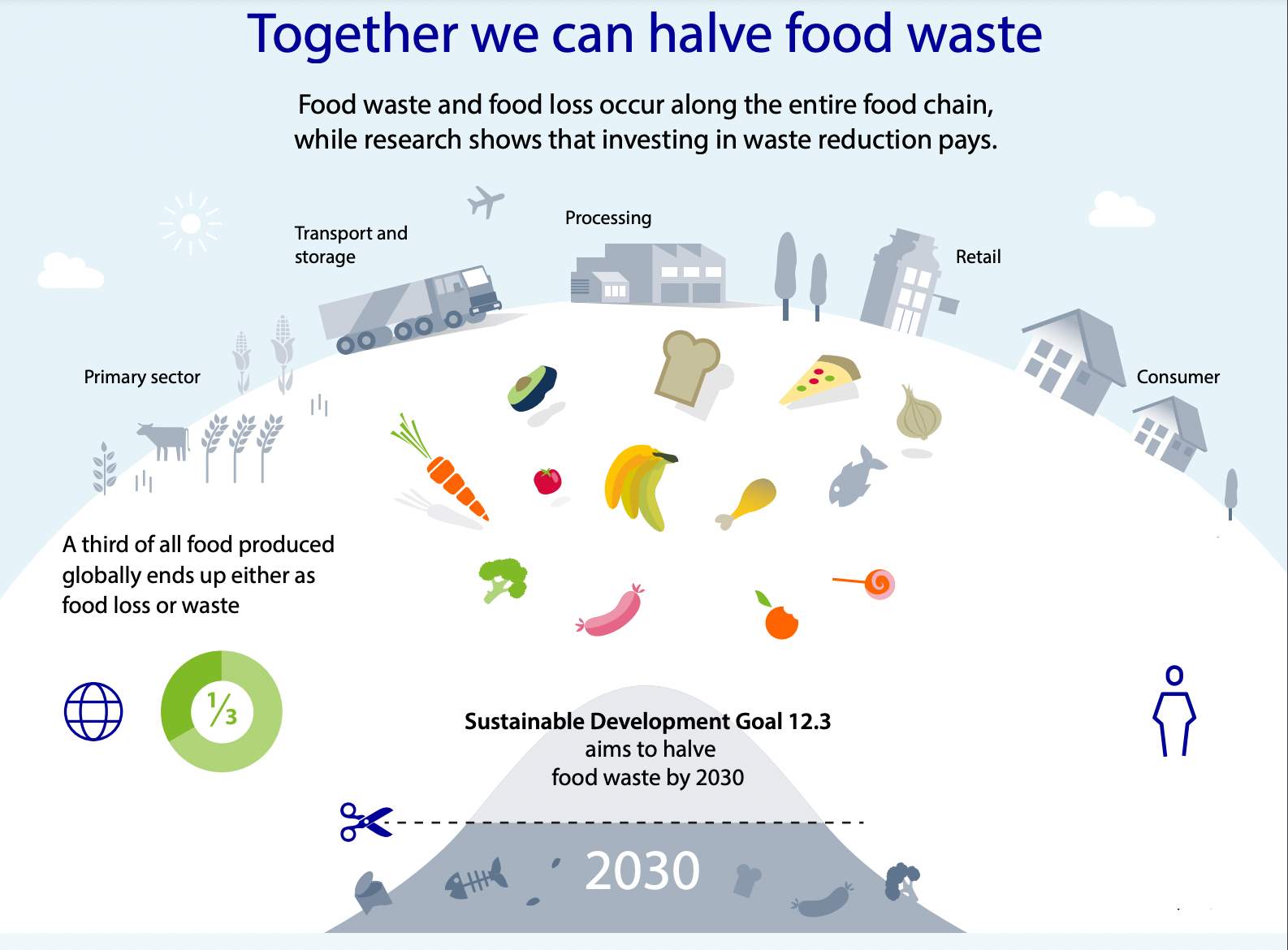
Food waste
Food waste refers to the removal of food from the food supply chain that is fit for consumption and of good quality or that has spoiled or expired. (14) Food is wasted in various ways by retailers, food service providers, and consumers:
Fresh produce which does not meet the optimal standards - for example, the shape, size and color - is often withdrawn during the sorting phase from the supply chain.
Retailers and consumers often discard food that is close to, at or beyond its expiration date.
Large quantities of edible food items are often unused, left over, and discarded by household kitchens and eating establishments. (FAO)
If only half of all the food that is lost or wasted was recovered, it would be enough to feed the entire population, ending world hunger. In 2020, between 720 and 811 million people faced hunger globally. Nearly 2.37 billion people (one in three people) did not have access to adequate food in 2020. (15)
Photo source: Getty Images
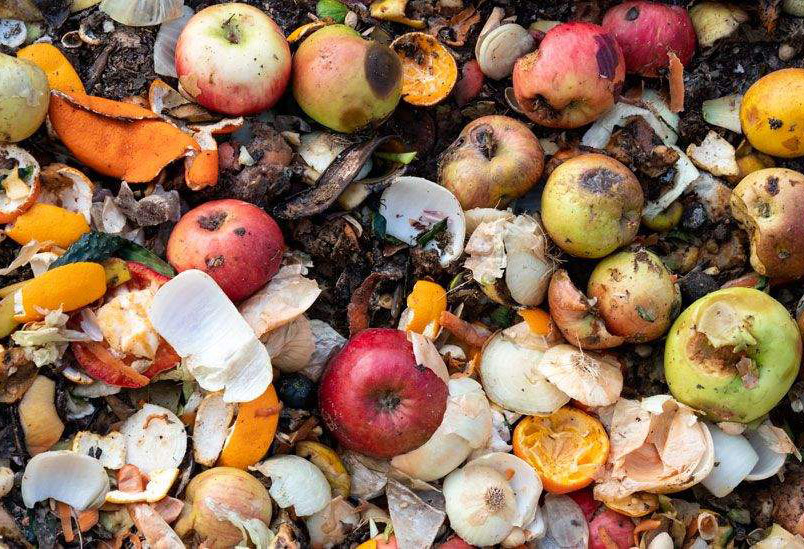
Environmental impact of food waste
Food that is never consumed represents a waste of resources, primarily water, land, and energy. Additionally, the global production of food is responsible for enormous amounts of greenhouse gas emissions that directly contribute to global warming and climate change. (16) The carbon footprint of food waste is estimated at 3.3 billion tonnes of CO2 released into the atmosphere annually. (14) Moreover, food waste burdens waste management systems while exacerbating food insecurity and biodiversity loss, which in turn has substantial environmental, social and economic impacts.
Photo source: Swiss Federal Office for the Environment
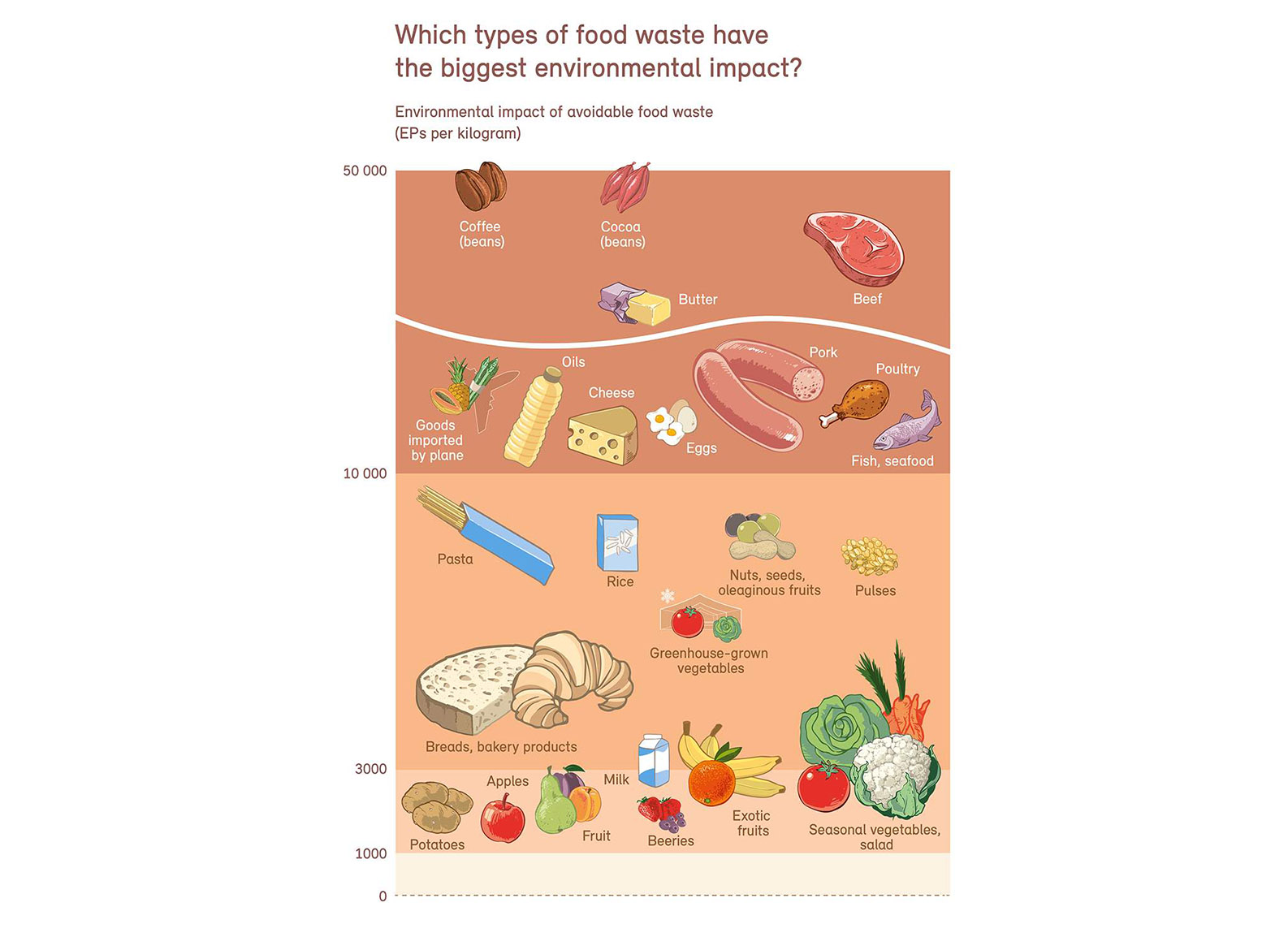
Landfills vs. composting
Most food waste ends up in landfills. However, to decompose it needs free-flowing oxygen. In the landfills, food waste is frequently tied in plastic bags and surrounded by more waste, and as a result, it undergoes a process called anaerobic decomposition. This type of oxygen-less decomposition causes the waste to release important amounts of methane (CH4) - a more powerful greenhouse gas than carbon dioxide (CO2). When food is composted in a well-maintained bin that lets in oxygen, it reduces the release of methane and contributes to healthier soils. (17) However, only a low percentage of all food is composted.
Part of the problem around food waste is that consumers buy more food than needed, let food spoil at home, or take larger portions than they can eat. Food waste can be tackled at the individual level, by changing our daily habits.
You can read about ways to reduce your food waste here.
Photo source: Rabobank

Food waste
Food waste refers to the removal of food from the food supply chain that is fit for consumption and of good quality or that has spoiled or expired. (14) Food is wasted in various ways by retailers, food service providers, and consumers:
Fresh produce which does not meet the optimal standards - for example, the shape, size and color - is often withdrawn during the sorting phase from the supply chain.
Retailers and consumers often discard food that is close to, at or beyond its expiration date.
Large quantities of edible food items are often unused, left over, and discarded by household kitchens and eating establishments. (FAO)
If only half of all the food that is lost or wasted was recovered, it would be enough to feed the entire population, ending world hunger. In 2020, between 720 and 811 million people faced hunger globally. Nearly 2.37 billion people (one in three people) did not have access to adequate food in 2020. (15)
Photo source: Getty Images

Environmental impact of food waste
Food that is never consumed represents a waste of resources, primarily water, land, and energy. Additionally, the global production of food is responsible for enormous amounts of greenhouse gas emissions that directly contribute to global warming and climate change. (16) The carbon footprint of food waste is estimated at 3.3 billion tonnes of CO2 released into the atmosphere annually. (14) Moreover, food waste burdens waste management systems while exacerbating food insecurity and biodiversity loss, which in turn has substantial environmental, social and economic impacts.
Photo source: Swiss Federal Office for the Environment

Landfills vs. composting
Most food waste ends up in landfills. However, to decompose it needs free-flowing oxygen. In the landfills, food waste is frequently tied in plastic bags and surrounded by more waste, and as a result, it undergoes a process called anaerobic decomposition. This type of oxygen-less decomposition causes the waste to release important amounts of methane (CH4) - a more powerful greenhouse gas than carbon dioxide (CO2). When food is composted in a well-maintained bin that lets in oxygen, it reduces the release of methane and contributes to healthier soils. (17) However, only a low percentage of all food is composted.
Part of the problem around food waste is that consumers buy more food than needed, let food spoil at home, or take larger portions than they can eat. Food waste can be tackled at the individual level, by changing our daily habits.
You can read about ways to reduce your food waste here.
Photo source: Rabobank


How does the world approach sustainability?
United Nations Sustainable Development Goals
The United Nations General Assembly adopted the 2030 Agenda for Sustainable Development in 2015. The Agenda consists of 17 Sustainable Development Goals and 169 accompanying targets that all UN Member States adopted and have agreed to work towards achieving by the year 2030. (UN) It is a universal call to action by all countries developed and developing to promote prosperity while protecting the planet through a global partnership. (18) The SDGs are a blueprint to achieve a better and more sustainable future for all. They address global challenges such as climate change, environmental degradation, and inequality.
Photo source: UN
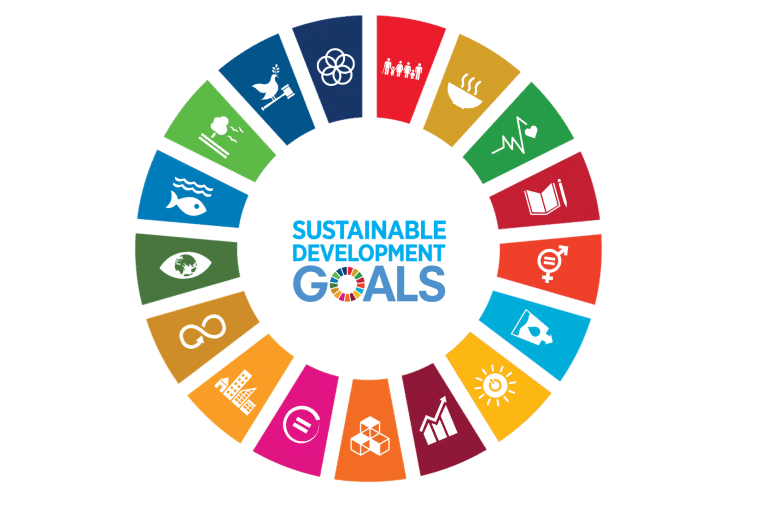

Structure of the framework
The doughnut consists of two concentric rings:
1. A social foundation to ensure that no one is left falling short on life’s essentials. These include 12 dimensions which are derived from internationally agreed minimum social standards, as identified in the SDGs.
2. An ecological ceiling to ensure that humanity does not collectively overshoot the planetary boundaries which protect Earth’s life-supporting systems. These include nine planetary boundaries, beyond which lie unacceptable environmental degradation and potential tipping points in Earth systems.
Between these two sets of boundaries lies a doughnut-shaped space that is both ecologically safe and socially just - a space in which humanity can thrive.
Photo source: Kate Raworth
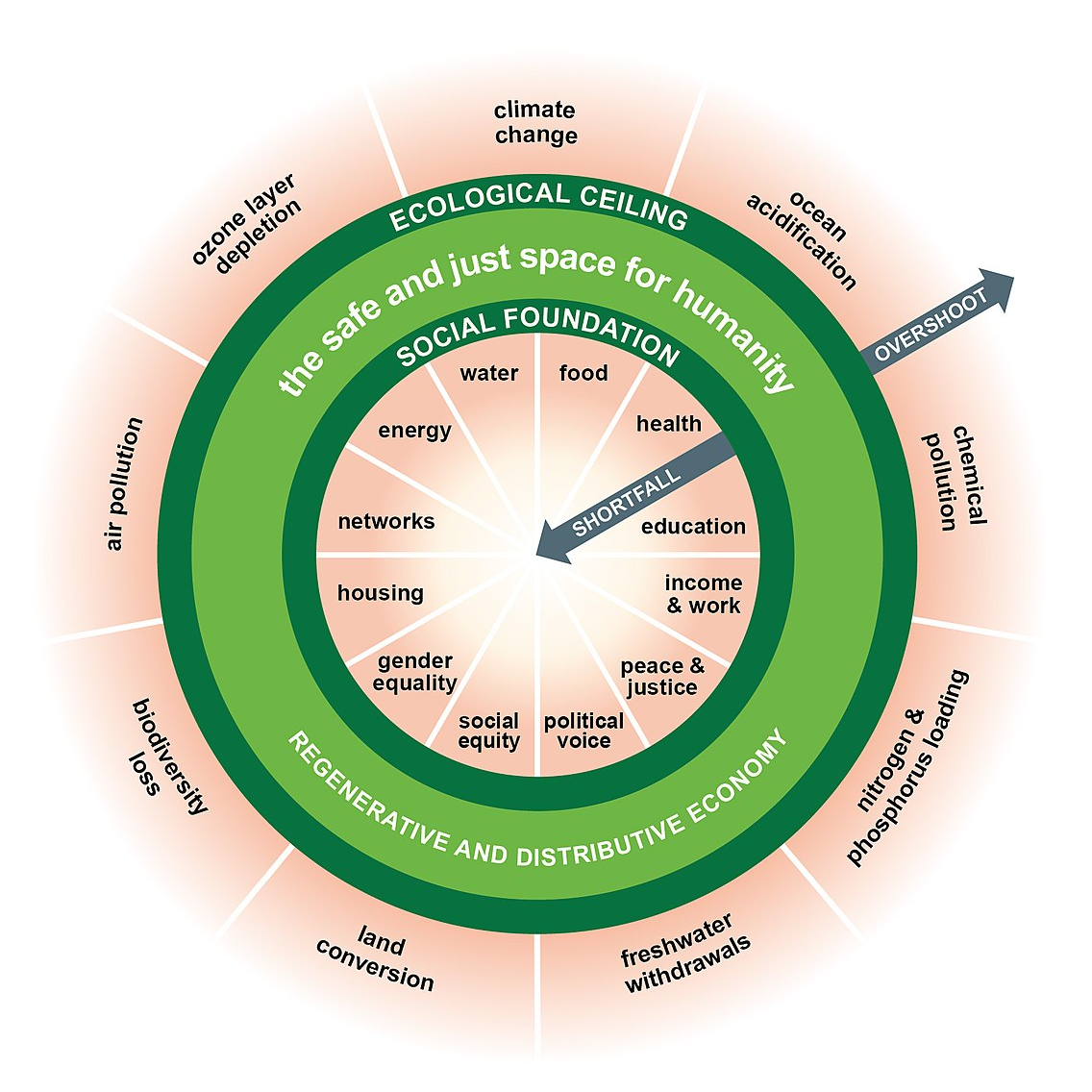
The Doughnut Economics Framework
Another way of approaching environmental sustainability is through the Doughnut Economics framework, a visual framework for sustainable development and social justice that combines the concept of planetary boundaries with the new concept of social boundaries. The framework, named after the shape of its diagram, is based on recent advances in both internationally agreed social standards and in Earth System Science, and it defines a path for human prosperity in the 21st century with the objective of meeting the needs of all individuals within the means of our planet. (Kate Raworth)
Structure of the framework
The doughnut consists of two concentric rings:
1. A social foundation to ensure that no one is left falling short on life’s essentials. These include 12 dimensions which are derived from internationally agreed minimum social standards, as identified in the SDGs.
2. An ecological ceiling to ensure that humanity does not collectively overshoot the planetary boundaries which protect Earth’s life-supporting systems. These include nine planetary boundaries, beyond which lie unacceptable environmental degradation and potential tipping points in Earth systems.
Between these two sets of boundaries lies a doughnut-shaped space that is both ecologically safe and socially just - a space in which humanity can thrive.
Photo source: Kate Raworth

The Doughnut Economics Framework
Another way of approaching environmental sustainability is through the Doughnut Economics framework, a visual framework for sustainable development and social justice that combines the concept of planetary boundaries with the new concept of social boundaries. The framework, named after the shape of its diagram, is based on recent advances in both internationally agreed social standards and in Earth System Science, and it defines a path for human prosperity in the 21st century with the objective of meeting the needs of all individuals within the means of our planet. (Kate Raworth)
Structure of the framework
The doughnut consists of two concentric rings:
1. A social foundation to ensure that no one is left falling short on life’s essentials. These include 12 dimensions which are derived from internationally agreed minimum social standards, as identified in the SDGs.
2. An ecological ceiling to ensure that humanity does not collectively overshoot the planetary boundaries which protect Earth’s life-supporting systems. These include nine planetary boundaries, beyond which lie unacceptable environmental degradation and potential tipping points in Earth systems.
Between these two sets of boundaries lies a doughnut-shaped space that is both ecologically safe and socially just - a space in which humanity can thrive.
Photo source: Kate Raworth

Do you have questions?
Ask The Earth Prize Mentors!
THIS WEBSITE USES COOKIES
We use cookies to provide you with the best possible experience. They also allow us to analyze user behavior in order to constantly improve the website for you. You can read more about our Cookie Policy and Privacy Policy.

